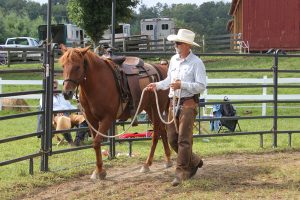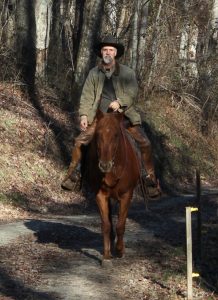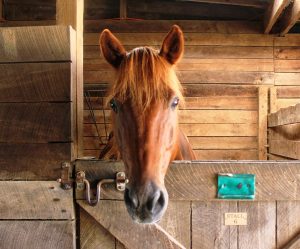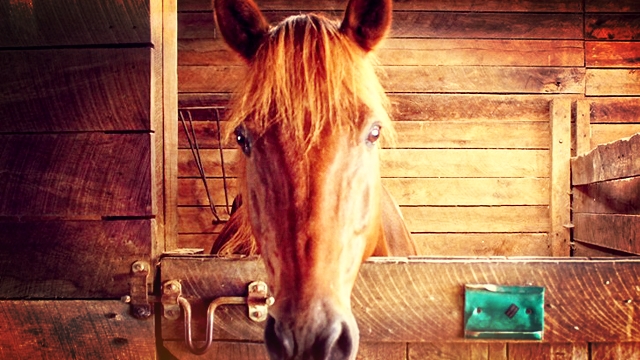Preface
Here’s a rarity! A previously unpublished chapter/essay from the vault. This chapter was written in 2008; at the time I had just wrapped up A Horse’s Thought and had begun working on the book Between the Reins. I’m not entirely sure why it didn’t make it into Between the Reins, or one of the later titles in the five-book Honest Horsemanship series, but it has sat collecting dust on a hard drive for more than a decade until I came across it this morning.
I think the reason that I never published this chapter is that I realized, even early on, that there are other things afoot in the moment described in it besides what my narrow understanding at that point could comprehend. Today, I would be much better equipped to see where Niji’s mind left the scene earlier, and to deal with it before having a huge issue to deal with. I still was missing so much, not that Niji ever made it easy! And I sure learned a ton from that sorrel gelding.
But I want to share this chapter now because it opens a window into a time early in my horsemanship journey when I was really trying to improve, and experiencing really trying times at times. I know for certain that anyone who sets out on a horsemanship journey will experience the kind of circumstances and frustrations that I recorded in this bit of writing. It takes me back, and I have enjoyed sharing the truth of my experience with you readers all along the way.
I hope you enjoy reading this time-capsule from my horsemanship past as much as I appreciated finding it and reflecting on Niji and the hardships and triumphs that have gone into getting me to where I am today, even as I struggle with different challenges and enjoy new successes with horses all the time!
Whisper if You Want…I Carry a Big Stick!
That was IT! The end of the rope. I decided right then to walk that horse home, pull the saddle, maybe throw it across the yard for good measure, and put Niji back in his paddock…forever!
I was furious! Seemingly once and for all totally overwhelmed. I’m typically a fairly cool cucumber, especially around horses. In that moment, however, I was so angry I retreated to the end of the twenty foot lead rope—as far away from the sorrel gelding as that instant allowed—and imploded.
It was the farthest down the horsemanship toilet I’d ever been flushed. And it only took six years of all-out hard work to get that lousy with horses.
I struggled to gather any microscopic trace of reason remaining to calm my unhinged mind, but the frustration boiled over spilling out of my wrenched soul in idiotic shouts, stomps, and flailings of the arm not attached to the lead rope, like a broken windmill (yes…much like a 2 year old; glad I live in the middle of nowhere; let’s keep this confession between us, shall we?).
 In the flash of a second while riding the gelding, Niji had gotten head-strong and pulled around against my request to stay straight and continue on the road. I held my request on the rein, not pulling against him, just holding until he hopefully got the idea and then a release. Instead we ended up off the road, down a hill, into the trees, and backwards in our relationship to a place I prayed I’d never see again.
In the flash of a second while riding the gelding, Niji had gotten head-strong and pulled around against my request to stay straight and continue on the road. I held my request on the rein, not pulling against him, just holding until he hopefully got the idea and then a release. Instead we ended up off the road, down a hill, into the trees, and backwards in our relationship to a place I prayed I’d never see again.It was not a spook, or a buck, or a run-off, or even particularly dangerous. To the onlooker it might have seemed funny, or ridiculous, or just a moment of temporary insanity ending in a circle back onto the farm road. In truth, however, it was a complete collapse of everything I had worked so hard and long to build up and get past with him.
The trouble crescendoed. That’s when I dismounted and lost my mind.
Two years I spent (no exaggeration) off-and-on working on this particular problem. The previous three months, I rode daily with the most excellent results. The problem even faded to little more than a distant memory. Then, to fall apart again in one terrible flash…it was, quite simply, more than I could take.
Niji kept tension on the rope, backing away, wide-eyed wondering what the heck was my problem? (Like he didn’t know! Looking so innocent.) If a tree had been any closer I would have beat my head against it, since I hadn’t tried that yet.
 The truth is that Niji didn’t know. I’ll grant him that. But when you work so hard and get through a sticky point with a horse, and then it returns worse than ever, it feels like the horse is just in-your-face choosing to defy you. This is the perfect example. We clearly worked through the head-strong problem. It disappeared completely for weeks—on exactly the same road, in exactly the same tack, with me offering exactly the same cues as now proved ineffective. It took near super-human effort to remind myself that it’s not defiance, that there are real reasons for the trouble. And that I just stink as a horseman.
The truth is that Niji didn’t know. I’ll grant him that. But when you work so hard and get through a sticky point with a horse, and then it returns worse than ever, it feels like the horse is just in-your-face choosing to defy you. This is the perfect example. We clearly worked through the head-strong problem. It disappeared completely for weeks—on exactly the same road, in exactly the same tack, with me offering exactly the same cues as now proved ineffective. It took near super-human effort to remind myself that it’s not defiance, that there are real reasons for the trouble. And that I just stink as a horseman.Well, that’s the way I felt about it at the time, anyhow. But, this is a story of redemption. It’s a recounting of how horse difficulties can seem overwhelming to the point that your horsemanship toolbox seems completely exhausted: turned upside-down, spilled out, and even shook hard to be sure nothing is stuck in there somewhere to try. Yet, by looking at the pile of past horsemanship experiences scattered on the ground at your feet for the ten thousandth time, you still can find the seeds of a new approach. An innovative slant to break the chain of trouble can catapult one from the toilet to the treetops. I was shocked at the about-face that happened two minutes after my meltdown with Niji. It simply remains one of the best examples of how a single tiny thread remained to pull me out of an equine abyss. The thinnest hair of help trailed back to an obscure memory of clinician Harry Whitney working at a clinic that ultimately got me thinking my way out of such a terrible downward spiral.
To make an incredibly long story short, the history of Niji’s head-strong deal leads back to the first time I began to ride him daily to feed the other horses two years earlier. That trek is a couple miles round-trip. One leg of the journey leads along a tight right of way, about 12 feet wide, defined by barbed wire fences on either side that ends at the bottom of a steep hill at a gate. We rode this route for three days with no problems. Then, returning on the fourth day, out of the blue, Niji refused to leave that gate and go up the hill. I exhausted every bit of pressure-and-release I could think of from the saddle to persuade him otherwise. Two horrendous afternoons trying to work it out ended in my retreat from that area altogether. This head-strong behavior then spilled over into other areas where it hadn’t been before. Even at the home paddock I suddenly had a full blown problem on my hands.
 I worked with the gelding over many months with some good progress on the problem. It never cleared out completely, though. Finally, for circumstances beyond my control, riding ceased here for many months. Niji got an unexpected vacation, and so did I.
I worked with the gelding over many months with some good progress on the problem. It never cleared out completely, though. Finally, for circumstances beyond my control, riding ceased here for many months. Niji got an unexpected vacation, and so did I.After the long sabbatical, I started again with Niji. I decided to start from the ground up to see if we could just dissolve the past problem with a re-start. Things went fantastic on the ground. I realized in retrospect, though, that the trouble never presented much in the ground work. Climbing into the saddle, things started out well riding him just around the paddock. Soon, to my dismay, the head-strong tendency reappeared. I committed to putting 90 days on him to see if dedication and consistency would overcome the issue.
By 60 days, we were back to roving the farm. My pressure and release experiments in general cleared out the problem, and we got on then without residual trouble of that head-strong defiance. I started riding him again to feed the other horses, going half the distance as before since no horses were in the far pasture beyond the gate of my nightmares where Niji’s trouble began. Life was great for three weeks! And then….
There I was losing my mind, leading Niji just after the head-strong issue returned that miserable day. What triggered it I guess I will never know. It just suddenly started as mysteriously as the first time.
Then, in a flash, two quick thoughts crossed my brain—first that I’d like to whack that horse with a big stick! (just an evil fantasy, of course)—which made me remember Harry using a flag from the saddle in the round pen one day. He reached out by the eye of a sticky, head-strong horse to turn him with flag pressure. It wasn’t simply a mechanical turning of a horse, though. In Harry speak, it was to, “block a thought.” The horse he rode was “committed to” going straight when Harry wanted to turn. The flagging worked by providing another means other than reins or legs to help block the horse’s idea of going straight like it wanted to, and come back to following his rider’s lead. I wondered if that would work here?
 There were sticks everywhere, so I got a nice one that was flag-like in length and feel. I mounted up and rode Niji down the road about five steps, and there we went, headed off the road to the left. As best I could, I worked rein and leg to adjust back, still giving him that chance first. As expected, he plowed right through my suggestion. So I stuck the stick out there into his field of vision. He stopped with, “What’s that?” surprise. Then plowed onwards with his agenda anyway.
There were sticks everywhere, so I got a nice one that was flag-like in length and feel. I mounted up and rode Niji down the road about five steps, and there we went, headed off the road to the left. As best I could, I worked rein and leg to adjust back, still giving him that chance first. As expected, he plowed right through my suggestion. So I stuck the stick out there into his field of vision. He stopped with, “What’s that?” surprise. Then plowed onwards with his agenda anyway.I held rein and leg and then shook the stick more, even tapping his jaw finally, and that horse reacted then and came right back to the road. I immediately dropped the stick from sight and went to a complete release as he walked nice and straight. Five steps later, he tried it again. Again I went through the same process in quick succession. Again the stick worked almost instantly. I am not lying when I say two minutes of flagging with that big stick was all it took to fix the trouble that had me so desperately overwhelmed for so long. At that point, the stick no longer even was needed the rest of the way home, and the ride was a joy.
I was overjoyed. Past experiences with Niji proved that once this problem starts, I’m doomed to weeks of regression with him. That’s why I was so distressed. This result was a miracle. I just couldn’t believe it.
Afterwards, two big points stuck with me. First, Niji quickly stopped being head-strong in all situations except one: where he sometimes (not always) sees other horses close by and wants to go to them. That remains a place where this problem persists, so the stick wasn’t a silver bullet completely clearing out all the troubles. However, there were profound changes immediately upon using the stick as a tool to break the terrible cycle we found ourselves in, over and over, for a very long time.
I am left reassured that new possibilities for getting beyond a problem with a horse are always at our fingertips if we just stop and see them. Experiences hopefully collect in our horsemanship lives that lead us to figure out possibilities that work towards clearing out troubles with our horses. Nothing fills our horsemanship toolbox with new tools like getting out and working with our horses, using some imagination, and surviving the lousy times. If I had thought about Harry using the flag to help block horses’ thoughts from the saddle to get them to a better place inside before (note that Niji was leaving the road not because he was relaxed and felt like a stroll, but because he was bothered inside causing him to forcibly turn and disregard my direction in a worried way), and used a flag to fix the problem at the very beginning of the original trouble two years earlier, it likely never would have grown to the monster it did. But, I plan to learn from my mistakes, and I won’t be putting Niji away into a paddock for life.
The other thing that nagged me about this whole trouble was how different Niji reacted when I was on the ground versus when I was mounted. Every single time his turning problem occurred, if I dismounted and took the lead rope, the gelding not only improved, but never fought against me. That “defiance” was saddle specific.
I asked Harry about this. He said that horses are usually quite willing to follow a strong leader, either within a herd of horses or with a human. But, the experience is always following another being that is on the ground and is clearly seen as a separate entity with body language at work. Some horses just don’t make the connection at first between the person on the ground calling the shots, and that same person who largely disappears from view onto the horse’s back where instructions are felt only and not really visual.
I was amazed that if I stood on the ground, even during an episode of trouble, and worked the reins giving the same exact cues I would from the saddle, Niji responded perfectly. But, the second I stepped up into the saddle and used those very same cues, I had absolutely no luck. Flagging from the saddle helped to put more of me into that outer, visual world than I ever could with just reins and legs.
This is a fundamental difference in understanding and key to why people think a horse is just insubordinate when, in truth, he’s just being a horse. So, whisper if you want to, but from now on I’m carrying a big stick!


